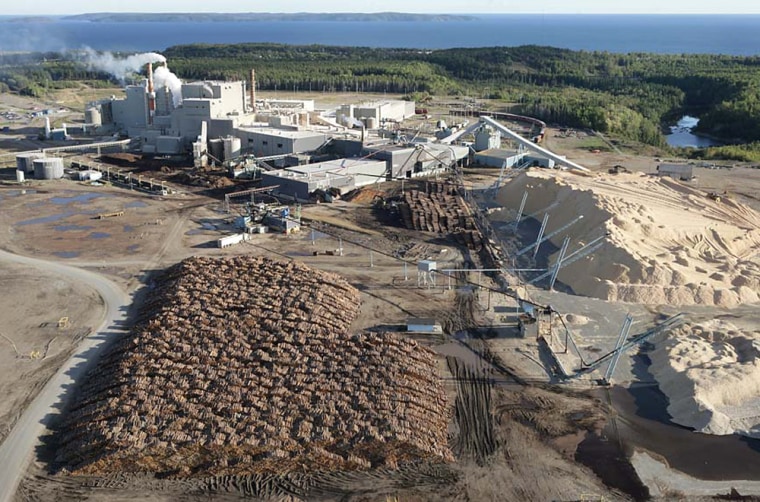REDMOND, Wash. — The topic can be delicate: what to wipe our hands, noses and, yup, rear ends with when the need arises. With Earth Day celebrated this Saturday, environmental groups are asking Americans to switch to recycled paper towels, napkins, tissue paper and toilet paper as a way to save virgin forests and the wildlife they shelter — even if it means a slightly rough touch on the backside.
“It’s such an easy change for people to make but has such a huge impact for saving forests,” says Sue Libenson, a spokeswoman for the Boreal Songbird Initiative, a group dedicated to protecting birds in Canada’s section of Earth’s boreal forest, a ring of trees below the Arctic that circles the globe. A source for much of the U.S. paper supply, Canada’s boreal forest is home to two-thirds of that nation's estimated 140,000 species of plants, animals and micro-organisms.
Greenpeace and the Natural Resources Defense Council are also pushing consumers to change their habits. The council has rated paper products (see link below) based on recycled content and whether they are whitened with chlorine, which can release toxins into the air and water when combined with other chemicals.
No top-selling household paper product uses recycled content, and activists believe that the industry prefers it that way — stocking store shelves with brands that compete over softness, a quality that comes from virgin tree fiber.
“We know people care about the environment,” says Darby Hoover, an NRDC staffer, but many consumers still don't realize they have a choice.
Recycled paper also can cost more because the market for it now is small. But what's the potential payback for switching? Seventh Generation, one of the largest recycled producers, estimates that:
- One million trees would be saved if every U.S. household replaced just one 250-count package of virgin fiber napkins with 100 percent recycled ones.
- 544,000 trees would be saved by replacing a 70-sheet roll of virgin fiber paper towels.
- 424,000 trees would be spared by replacing a 500-sheet roll of virgin fiber toilet paper.
- 170,000 trees would be saved by replacing one 175-count box of virgin fiber facial tissue.
Industry: People want virgin fiber
Paper industry giants like Kimberly-Clark, which makes Kleenex, dismiss the campaign on several grounds.
Most of its products are made with sawdust and wood chips left over by the timber industry, Kimberly-Clark says, and consumers have already decided that you can’t beat virgin fiber for softness.
“The options are out there for consumers,” says Kimberly-Clark spokesman Dave Dickson, referring to the fact that recycled products are on store shelves but have only won a 2 percent share of the market. “They have voiced their preferences through their purchases.”
Even though most hotels and offices use paper with 40 percent to 60 percent recycled content, Kimberly-Clark believes that consumers would rebel at even adding a small percentage of recycled fiber to home products, Dickson says.
Getting to the bottom
Always ready to get to the bottom of a controversy, I enlisted my wife and two children to help me conduct some tests.
Using the NRDC list, I purchased as many of the recycled products as I could find from a natural foods store and two traditional supermarkets.
While the family was away, I replaced our household paper products with recycled brands. After three days and zero comments, I took that as a sign that we could live happily ever after with recycled.
But another round of tests — this time blind comparisons — revealed sometimes strong preferences, especially among the females in our clan. Here’s our summary for the four types of products:
Paper napkins: Dabbing our mouths with one non-recycled brand and three recycled ones over dinner, my wife and daughter were quick to single out the non-recycled napkin as the most comfortable to the touch. In the words of Alexis, our 14-year-old: “It was better than all the sandpaper napkins.” Nicolas, our 18-year-old son, preferred the recycled Seventh Generation napkin, which Gabriela, my wife, disliked as “waxy.” As for me, I had no preference.
Paper towels: Three recycled brands went up against a non-recycled one. We all disliked the recycled Green Forest towel, calling it stiff and even noisy. “It doesn't even fold,” Nicolas said as he held it up to demonstrate. But the other two recycled towels, Earth First and Whole Foods 365, fared as well as the non-recycled towel.
Tissue paper: I'd only found one recycled brand and it bombed against the two non-recycled tissues we had at home. We all felt the recycled Seventh Generation tissue was too thin. “See-through,” is how Alexis described it. “Not enough barrier” between the fingers and phlegm, was Nicolas' response.
Toilet paper: Here too, my wife and daughter were quick to pick the non-recycled brand out of the five tested. Gabriela had one word for her favorite: “Beautiful.” In equally dramatic fashion, Alexis worried about getting paper cuts from the recycled brands. I agreed the non-recycled brand was softer in one’s hand, but insisted it made no difference on the receiving end of the transaction. We did agree on one thing: Every recycled brand, all of which were double ply, beat the single-ply paper we’ve been using in our guest bathroom.
Closing thoughts
Our advice to readers? Try this experiment at home with as many recycled products you can find.
We all agreed that in the usual course of using a paper product, we probably wouldn't be as picky as we were during the tests, with one exception: When it comes to wiping a runny nose over several days, we made tissue softness a priority.
If you can live with a recycled product, a next step might be to compare prices. Recycled products do tend to cost more, but the NRDC’s Hoover says buying in bulk, and even buying recycled paper made for hotels and offices, can add up to savings.
And that, dare we say, is our bottom line.
